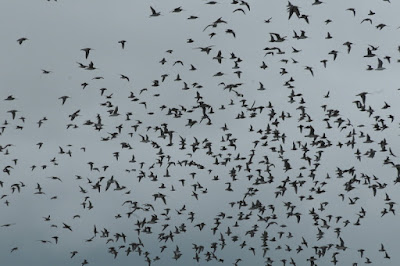To see it, we set out across the boggy flats of the estuary, in my case clutching a spotting scope conveniently rented from the centre headquarters.
Our target was a rather battered hide overlooking the estuary waters, already crammed with visiting birders.
Across the water, literally thousands of shorebirds (or waders, if you're not from North America) crowded together, waiting for the lowering of the tide, repeatedly bursting into wheeling flight. Many of them were migrants from the north: Bar-tailed Godwits (Limosa lapponica), Red Knots (Calidris canutus) and others.
Among them, though, were the birds I sought: Wrybill Plovers (Anarhynchus frontalis), the only bird in the world with a bill that twists sideways. It, too, is a migrant at Miranda, not from the north but from breeding grounds on braided streams in the South Island (where its peculiar bill is useful for retrieving small invertebrates from beneath rounded river stones).
There are only about 5300 Wrybills left, and up to 40% of them winter at Miranda. Unlike the New Zealand Dotterels I saw at Opoutere, they never came close (a pity, as I would have loved to get a good look at that weird bill). As a consolation, their aerial evolutions were both beautiful and spectacular. It's not often you can see roughly one third of a bird's global population in a single binocular field!
We lingered for quite a while with the Wrybills, but finally made our way back across the flats, past small chattering groups of Pied Stilts (Himantopus leucocephalus).
Here we saw both of New Zealand's larger resident herons. This is a White-faced Heron (Ardea novaehollandiae).
The Eastern Great Egret (Ardea modesta), an abundant bird elsewhere, is a prized rarity in New Zealand (where it is know as the Kōtuku or White Heron), where it breeds only in the Okarito Lagoon on the South Island.
The egret brought us to the end of our natural history experiences on this trip to New Zealand. From here we headed back to Auckland to visit friends before heading off to Australia, our next destination. Was the trip a success? Eileen's expression, I think, makes the answer abundantly clear!





















No comments:
Post a Comment